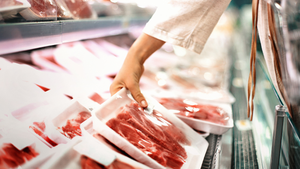INITIATIVE 3:Cultivate Connections With Local Farms
The local food movement is one of the most exciting trends to hit supermarket produce departments in recent memory. Organics initially satisfied consumer demand for food grown, raised and produced free of chemical pesticides and all things artificial. But many of the core shoppers who helped drive that movement into the mainstream are now turning their attention toward broader environmental concerns,
December 17, 2007
Matthew Enis
The local food movement is one of the most exciting trends to hit supermarket produce departments in recent memory. Organics initially satisfied consumer demand for food grown, raised and produced free of chemical pesticides and all things artificial. But many of the core shoppers who helped drive that movement into the mainstream are now turning their attention toward broader environmental concerns, such as food miles.
Local food's roots run deeper than that, though. Shoppers view local produce and products as fresher and more flavorful. Big-city activists like the fact that less fuel was used to get the food to their table; rural America likes the fact that buying local supports their local farms and local economy. Everyone in between just enjoys feeling some sort of connection to the land.
“Food has literally become the new social movement,” said Produce Marketing Association President Bryan Silbermann during his 2008 State of the Industry speech at this year's PMA Fresh Summit. “For a rising number of consumers, particularly the moms we know and love so well, being connected to their food is a force that has returned. They aren't ready to return to World War II-era Victory Gardens in backyards, but they are wanting to connect to and support businesses that understand ‘more’ and ‘cheap’ are not necessarily ‘better.’”
The official numbers from the U.S. Department of Agriculture illustrate the trend with some degree of clarity. Published every two years, the agency's “National Directory of Farmers Markets” accounted for almost 4,400 U.S. markets in 2006, an 18% increase over 2004, and almost double the number of local farmers' markets listed a decade earlier.
Things are moving quicker than that, though. A game of one-upsmanship has begun in the environmentalists' corner, with books like “The 100 Mile Diet” and “Food not Lawns: How to Turn Your Yard Into a Garden and Your Neighborhood Into a Community” published recently. And, there are already more than 1,000 “Community Supported Agriculture” programs in the U.S. that enable people to become stakeholders in local farms — paying in advance for a weekly delivery of produce, or even going to work on the farms for a few hours each month.
Leading retailers have already recognized this trend as the big opportunity it is, rather than the emerging threat it could be. Most supermarkets source at least some of their produce locally, and are now highlighting those products in-store when possible. Growers' cooperatives have been forming throughout the country, allowing small farmers to pool their resources and fulfill the demands of larger clients, such as regional supermarket chains. Whole Foods has even begun a loan program to offer expansion funds to farmers they work with regularly.
And a number of retailers have begun hosting farmers' markets in their own parking lots — with excellent results.
For example, David Skogen, owner of Skogen's Festival Markets, LaCrosse, Wis., has farmers' markets operating regularly in the parking lots at 10 of his 12 stores. When SN asked in August whether the markets had caused produce department sales inside the store to drop off, he said, “Absolutely not. Just the opposite. It builds store traffic, goodwill and good relationships with the farmers and with our customers.”
About the Author
You May Also Like






